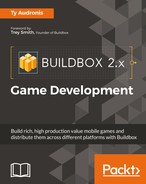Of course, you should have either a device or emulator for every platform you intend to compile for. An emulator is a piece of software that can mimic a device on the desktop of your computer. You'll need these devices and/or emulators to make sure your app isn't taxing the processing power and memory of a device too much. Although a game could test fine on your desktop, it may prove to be too much for a device to handle.
Additionally, you'll definitely need a Mac of some sort to compile for Apple devices. Unfortunately, the compiler for iOS, tvOS, and Macintosh only runs on Mac. We'll be developing (using Buildbox) on a PC, and compiling for Apple using a Mac Mini for the projects in this book.
To effectively develop a game, you'll also need some sort of image editing software. In this book, we'll be using Adobe Photoshop CC2015 and Illustrator CC2015; however, there are freeware solutions available (such as GIMP—available here: https://www.gimp.org/downloads/).
A worthwhile game absolutely must have good sound. Therefore, a developer must have a decent audio editing application. In this book we'll be using a combination of Presonus Studio One 3 Professional and Adobe Audition CC2015. Again, a freeware option known as Audacity is available from SourceForge at https://sourceforge.net/projects/audacity/.
Finally, to create animated assets (such as enemies, explosions, and so on), it's advisable to get a 3D animation program to speed things up. In this book we shall use LightWave 3D 2015; however, yet again, a freeware option known as Blender is available (https://www.blender.org/).
It is not entirely necessary for a developer to create their own graphic and audio assets. You could always hit up Fiverr (https://www.fiverr.com/) or similar services to have custom graphics and audio made for you. However, as this is a complete book on developing a game using Buildbox, we will be covering how to create these assets yourself.
Granted, this greatly exceeds the minimum needed for game development with Buildbox. However, this should give you a good idea of the capabilities necessary, and it's nice to have for game development.
|
Processor |
Intel I7 5960X |
|
Memory |
32 GB 3000Mhz DDR4 |
|
Hard drives |
512 GB Solid State Boot Drive
10TB RAID 0 SATA II Internal
10TB RAID 1 USB 3.1 External Backup
4TB Seagate Baracuda Docked USB 3.0 Archival Backup
|
|
Motion capture (not necessary at all for Buildbox, but helpful for graphics creation) |
XBOX One Kinect with USB 3.0 adapter |
|
Color accuracy (not necessary at all for Buildbox, but helpful for graphics creation) |
Pantone Huey Pro |
|
Monitor |
Samsung 4K oLED |
|
Audio |
Presonus FireStudio Project USB 3.0 Interface with Presonus powered speakers |
|
Music hardware |
Roland Fantom X6, Roland MC 909, various guitars and basses |
|
Software |
Windows 10 Pro x64, Buildbox 2.0, Android SDK 2, Adobe Creative Cloud 2015, LightWave 3D 2015, Brekel Pro motion capture, Presonus Studio One 3 Pro |
Developing a game is only half the picture. Yes, it's cool to be able to play your own games, but wouldn't it be better to have the world play them? Better yet...wouldn't it be better to make a profit? That's where distribution channels come in.
Distribution channels, such as iTunes, Steam, and Google Play, are places where platform owners go to shop for new apps and games. But for each device, there are unique distribution channels, and in some cases multiple ones (such as Google Play and Amazon Apps for Android devices).
In order to develop for Apple devices, you're going to need a subscription to the Apple Developer Program. It is an annual fee, and can be expensive (when compared to Android). Speaking of which, you'll also need a membership to the Google Play developer program, and Amazon developer program.
For Windows games, you will need a Steam account, and to authorize it, to submit programs to Steam Greenlight. You will also need a Windows Dev Center account.
As you can see, if you sign up for all of the various services as a developer, the costs can run up. So, it's probably going to be important to make up your mind on the target for your games before you begin developing. The bonus is that if your game does well on one platform, it's very easy to port it to another (because one Buildbox project can generate the same game across multiple platforms).
